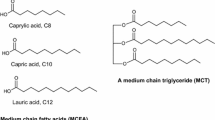Abstract
Conjugated linoleic acid (CLA) refers to a mixture of naturally occurring positional and geometric isomers of linoleic acid that exist in dairy products and meat. The aim of the present work was to study the effects ofc-9,t-11 andt-10,c-12 CLA isomers on body fat accumulation and serum lipids in hamsters fed an atherogenic diet. Hamsters were divided in four groups: one group was fed a chow diet (control) and the other three groups were given semi-purified atherogenic diets with 0.5% linoleic acid (LA),c-9,t-11 ort-10,c-12 CLA. Body weight and food intake were measured daily. After 6 weeks, adipose tissues from different anatomical locations and liver were dissected and weighed. Serum glucose, total cholesterol, HDL-c, LDL-c and triacylglycerol levels, as well as total and free cholesterol, triacylglycerol and phospholipid content in liver were determined by enzymatic methods. No differences in either energy intake or final body weight were found. The addition oft-10,c-12 CLA reduced fat accumulation and led to lower serum cholesterol, as compared with LA group. Nevertheless the level remained higher than in the control animals. The reduction in serum cholesterol was limited to LDL-c. This isomer also reduced triacylglycerol content in liver but did not modify serum triacylglycerol level. In summary, the present study demonstrates thatt-10,c-12 CLA is the biologically active agent when anti-obesity and hypocholesterolaemic properties of CLA are considered. In contrast, the isomerc-9,t-11 has no effect on lipid metabolism in hamsters.
Resumen
El término ácido linoleico conjugado (ALC) se utiliza para designar una serie de isómeros del ácido linoleico, presentes en los lácteos y la carne, que presentan los dobles enlaces en posición conjugada. El objetivo del presente trabajo consistió en estudiar el efecto de los isómerosc-9,t-11 yt-10,c-12 del ALC sobre la acumulación de grasa corporal y los lípidos séricos, en hámsters alimentados con una dieta aterogénica. Los hámsters se distribuyeron en cuatro grupos: un grupo recibió pienso de laboratorio (control) y los otros tres grupos, dietas aterogénicas con 0,5% de ácido linoleico, ALCc-9,t-11 ó ALCt-10,c-12. Se midió diariamente la ingesta de alimento y el peso corporal. Tras 6 semanas, se diseccionaron y pesaron los tejidos adiposos de diferentes localizaciones anatómicas y el hígado. Se midieron las concentraciones séricas de glucosa, colesterol total, c-HDL, c-LDL y triglicéridos, y el contenido hepático de colesterol total y libre, triglicéridos y fosfolípidos, por métodos enzimáticos. No se encontraron diferencias significativas ni en la ingesta de energía ni en el peso corporal final. El isómerot-10,c-12 redujo la acumulación de grasa y disminuyó el colesterol total sérico; no obstante, su nivel se mantuvo por encima del de los animales control. La reducción del colesterol sérico se produjo a expensas del c-LDL. Este isómero también disminuyó el contenido hepático de triglicéridos pero no modificó los triglicéridos séricos. El presente estudio demuestra que el isómerot-10,c-12 del ALC es el biológicamente activo como agente anti-obesidad e hipocolesterolemiante. Por el contrario, el isómeroc-9,t-11 no afectó al metabolismo lipídico en hámsters.
Similar content being viewed by others
References
Arbeeny, C. M., Meyers, D. S., Bergquist, K. E. and Gregg, R. E. (1992):J. Lipid. Res.,33, 843–851.
Azain, M. J., Hausman, D. B., Sisk, M. B., Flatt, W. P. and Jewell, D. E. (2000):J. Nutr.,130, 1548–1554.
Belury, M. A., Moya-Camarena, S. Y., Liu, K. L. and Vanden Heuvel, J. P. (1997):J. Nutr. Biochem.,8, 579–584.
Brown, M. S., Kovanan, P. T. and Goldstein, J. L. (1981):Science,212, 628–635.
Chin S. F., Liu, W., Storkson, J. M. and Pariza, M. W. (1992):J. Food Comp. Anal.,5, 185–197.
Christie, W. W., Dobson, G. and Gunstone, F. D. (1997):Lipids,32, 1231.
Daumiere, C. M., Woollett, L. A. and Dietschy, J. M. (1992):Proc. Natl. Acad. Sci. USA,89, 10797–10801.
De Deckere, E. A., van Amelsvoort, J. M., McNeill, G. P. and Jones, P. (1999):Br. J. Nutr.,82, 309–317.
DeLany, J. P., Blohm, F., Truett, A. A., Scimeca, J. A. and West, D. B. (1999):Am. J. Physiol.,276, R1172–1179.
Diestchy, J. M., Turley, S. D. and Spady, D. K. (1993):J. Lipid Res.,34, 1637–1659.
Folch, J., Lees, M. and Sloane Stanley G. H. (1957):J. Biol. Chem.,226, 497–509.
Gavino V. C., Gavino, G., Leblanc, M. J. and Tuchweber B. (1999):J. Nutr.,130, 27–29.
Kim, M. R., Park, Y., Albright, K. J. and Pariza, M. W. (2002):Nutr. Res.,22, 715–722.
Kris-Etherton, P. M. and Diestchy, J. M. (1997):Am. J. Clin. Nutr. (suppl.),65, 15905–15965.
Kritchevsky, D., Tepper, S. A., Wright, S., Tso, P. and Czarnecki, S. K. (2000):J. Am. Coll. Nutr.,19, 472S-477S.
Lee, K. N., Kritchevsky, D. and Pariza, M. W. (1994):Atherosclerosis,108, 19–25.
Martin, J. C. and Valeille, K. (2002)Reprod. Nutr. Develop. 42: 525–536
Nicolosi, R. J., Rogers, E. J., Kritchevsky, D., Scimeca, J. A. and Huth, P. J. (1997):Artery,22, 266–277.
Pariza, M. W. (1988):Ann. Rev. Nutr.,8, 167–183.
Pariza, M. W., Park, Y. and Cook, M. E. (2001):Prog. Lipid Res.,40, 283–298.
Reeves, P. G., Nielsen, F. H. and Fahey, G. C. (1993):J. Nutr.,123, 1939–1951.
Roschlau, P., Bernt, E. and Gruber, W. (1974):Z. Klin. Chem. Klin. Biochem.,12, 403–408.
Sakono, M., Yuji, K., Miyanaga, F., Tamuru, S., Fujita, M., Fukuda, N. Tsutsumi, K., Kasai, M. and Sugana, M. (2002):J. Nutr. Sci. Vitaminol.,48, 405–409.
Sugiyama, Y., Odaka, H., Ihokawa, S., Ishikawa, E., Tomari, E. and Ikada, H. (1995):Atherosclerosis,118, 145–151.
Terpstra, A. H. M., Beynen, A. C., Everts, H., Kocsis, S., Katan, M. B. and Zock, P. L. (2002):J. Nutr.,132, 940–945.
Tsuboyama-Kasaoka, N., Takahashi, M., Tanemura, K., Kim, H. J., Tange, T., Okuyama, H., Kasai, M., Ikemoto, S. and Ezaki, O. (2000):Diabetes,49, 1534–1542.
West, D. B., Delany, J. P., Camet, P. M., Blohm, F., Truett, A. A. and Scimeca, J. (1998):Am. J. Physiol.,275, R667–672.
Wilson T. A., Nicolosi, R. J., Chrysam, M. and Kritchevsky, D. (2000):Nutr. Res.,20, 1795–1805.
Yeung, C.H.T., Yang, L., Huang, Y., Wang, J. and Chen, Z. Y. (2000):Br. J. Nutr.,84, 935–941.
Author information
Authors and Affiliations
Corresponding author
Rights and permissions
About this article
Cite this article
Navarro, V., Zabala, A., Macarulla, M.T. et al. Effects of conjugated linoleic acid on body fat accumulation and serum lipids in hamsters fed an atherogenic diet. J. Physiol. Biochem. 59, 193–199 (2003). https://doi.org/10.1007/BF03179915
Received:
Issue Date:
DOI: https://doi.org/10.1007/BF03179915




